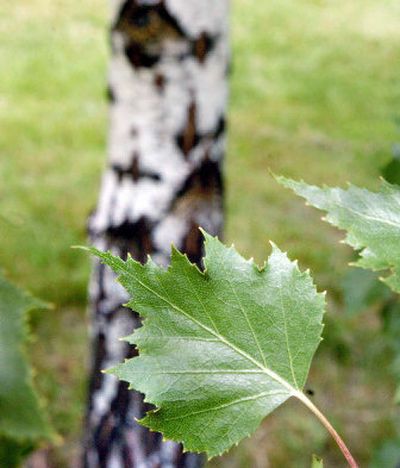Birches need lots of TLC

Birch trees are a very popular landscape tree in our region. It’s hard to beat the beautiful white bark of the European weeping birch, the peeling but colorful bark of river birch or the shiny green leaves and graceful form all the varieties have. But as popular as they are, birch trees – particularly European white birch – are not easy to grow in the Inland Northwest. A walk or drive around almost any neighborhood in the region will reveal birches with dead or dying tops and a generally unhealthy look to them.
In their natural habitat, birches grow where their roots can stay cool and moist even during the hottest part of the year. Often they are found amongst other trees at the edge of the forest where their roots are shaded yet their crowns are in full sunlight. Their roots are very shallow and very sensitive to dry conditions even for a very short period.
The attributes that make the birch a popular landscape tree actually often set the homeowner and the tree up for failure. Many homeowners want to showcase the tree’s white bark and shape in a prominent place in the yard. Unfortunately, that is usually in the middle of the front lawn exposed to the hot sun and surrounded by the most water-hungry plant in the garden – the lawn. As a result, instead of their roots being cooled by the shade of other trees, birches are getting baked. The lawn often planted on top of them takes most of the water leaving the birch roots dry. Throw in poor soil conditions and you have a recipe for utter failure.
To finish the injustice, most homeowners then rely on the sprinklers set to keep the lawn happy (1 inch per week) and expect it to also water the birch. It simply doesn’t work. The roots of the tree get too hot and the lawn pulls all the moisture out of circulation before it gets to the tree roots. The result is a stressed tree that begins dying back in a few short years, long before it should.
The final death knell for the poor tree however usually comes in the form of the bronze birch borer. The birch borer is a small, metallic bronze-colored beetle that attacks weakened or stressed birches. Scientists believe that birches under stress from drought or heavy pruning send out some kind of a physiological signal that draws the birch borer to the tree. Adult birch borers actively seek out stressed trees from May to August.
The females lay eggs on the trunk of the tree. After hatching, the larvae bore into the tree and begin feeding on bark under the surface. Eventually they eat their way around the cambium layer of bark girdling the tree. This cuts off its ability to transport water and food up and down the trunk, killing the tree.
Often the first signs a tree has been infested are stunted leaves and dying twigs at the top of the tree. To confirm the presence of the borers, look for worm-like trails under the bark and the presence of D-shaped holes in the trunk where the larvae emerged to go to their next target.
A tree will often die in stages. The first year the top will die, followed the next year by the next lower section or one member of a clump planting. Once a tree has suffered a dieback of about 25 percent, it is very difficult to save.
While providing the tree with a healthy growing environment in the first place is the best treatment against birch borers, they can be slowed down by the proper application of the insecticide Sevin. The insecticide is painted on the lower trunk of the tree before the adult females start laying eggs in May, and then once a month through August, the flight period for the borer. This prevents additional attacks but does not kill insects already under the bark.
Avoid pruning birches between May and the end of August. Fresh pruning wounds are a magnet for female borers. If you have to make a cut during this time, paint the cut with Sevin to deter any curious bugs.